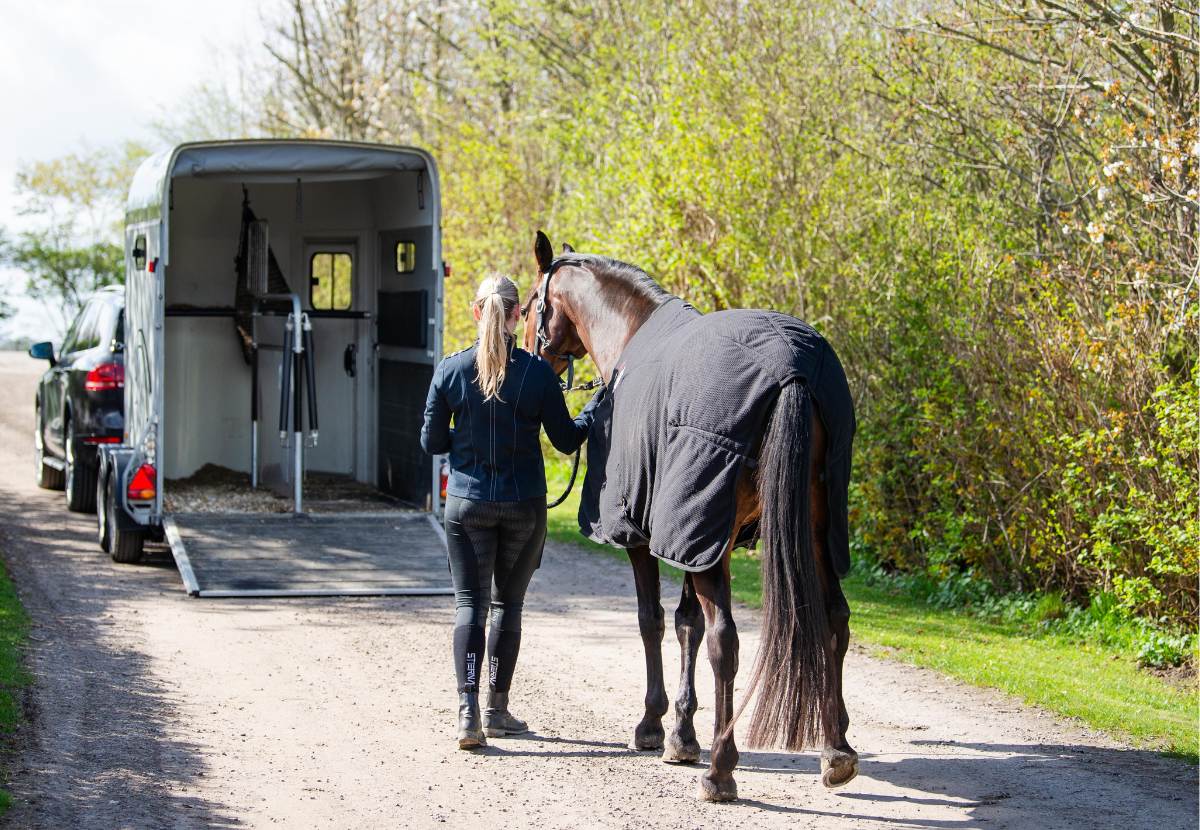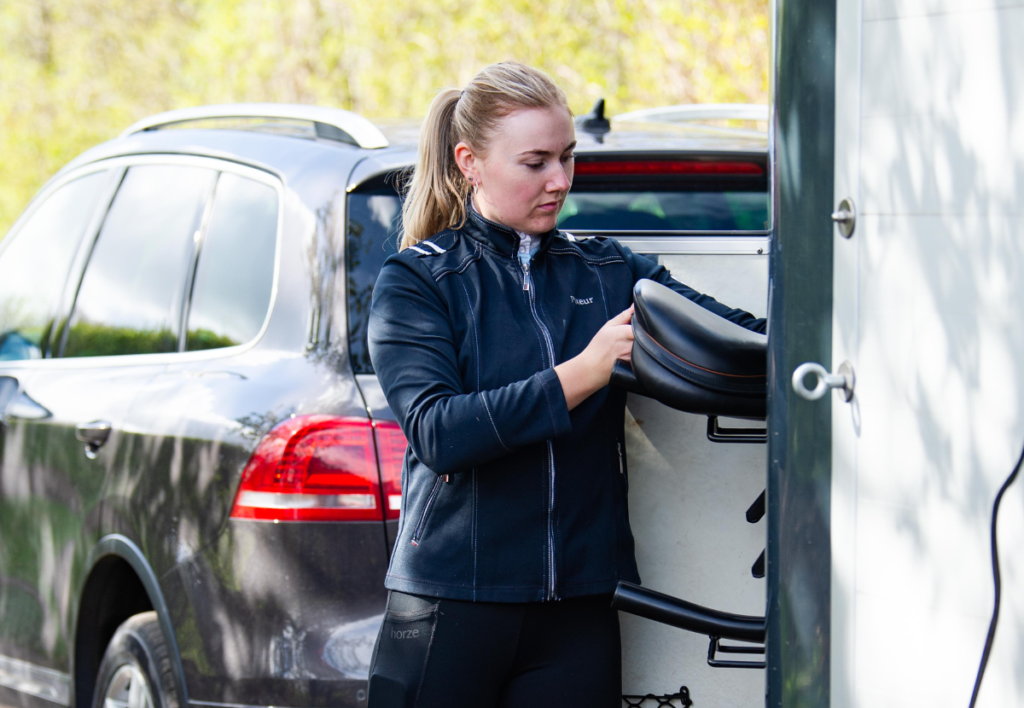Menu

You're not alone in encountering issues with trailer loading.
Have you ever found yourself dealing with a horse after a competition, late in the afternoon when everyone is tired and keen to get home, but the horse refuses to go into the trailer? It's frustrating, and you've probably been asked many times if you need a helping hand or a loading rope. You're not alone in this experience: studies show that many other horse owners have faced the same issue. Trailering can make horses anxious and nervous, and there's a need for more knowledge about how we can avoid these problems and load horses better.
Gemma is a trained veterinarian, and she divides her time between research and outreach work in horse behavior on behalf of The Horse Trust in the United Kingdom. She is a specialist in horse behavior at the University of Edinburgh and also works as a consulting veterinarian for the organization The International Society for Equitation Science. Gemma is passionate about improving interactions between horses and humans, especially with regard to the application of learning theory.
Also check out: What importance does stable design have for a horse’s welfare?
Even if your horse willingly enters the trailer, it can be very stressful each time it is transported. Professor Gemma Pearson, a vet in Edinburgh, has recently surveyed horse owners to see how common the issues of loading your horse were, what circumstances surrounded it, and how it affects the relationship between horses and humans. The survey suggests that trailer loading is the most stressful part of transporting horses. Far too often, the horses or the people loading them get injured.
If we pay attention to what stresses horses and take precautions the horse's discomfort is minimized, it can help the horse load into the trailer safely.
Gemma Pearson at the conference for The International Society for Equitation Science in Hartpury, UK
Gemma Pearson and her colleagues distributed a questionnaire on social media.
They received 1040 responses, from women aged 36-55 years, the vast majority of whom had over 20 years of experience with horses. The horses were of various breeds, and the majority were geldings between 11 and 15 years old. The most common activity was forest riding, but activities within dressage and jumping were also part of the responses. Most of the horses were transported in a standard horse trailer, about once a month and the journey took less than an hour.
Also check out: Give the horses an interesting paddock
70% of the responses reported that the horse boarded the trailer without obstacles. However, it was also reported that out of these, 40% reported that the horse sometimes swayed its hindquarters to the side, or dug its feet into the ground and refused to proceed. Even though the horse owners didn't think there were problems with loading, 98% of the horses showed signs of negative stress behavior during loading. This could be head shaking, scratching the ground, or defecating. This behavior signals that the horse isn't comfortable with the situation, and Gemma Pearson emphasizes the importance of taking these signs seriously. It's crucial not to normalize these signs as being the usual behavior when the horse is being loaded, she explains. Only two percent of all responses reported no negative stress behavior.

Out of the 30% of responses that reported that the horses had trouble loading into the trailer, the most common problem was the horse stopping at the ramp and refusing to move forward. When asked why the horse had problems getting into the trailer, the answer was that the horse might have had a negative experience. Fear and pain were also high on the list of possible causes. Gemma Pearson sees this as a sign of a change in our view of the horse. If the same questions had been asked 10 years ago, answers such as the horse being naughty, stubborn, or dominant would have been at the top of the list, she believes.
The owners who faced issues with loading their horses worked with different solutions, Gemma Pearson shares. The majority sought help from an experienced friend or colleague. Some used a different type of halter, new headgear, or a form of physical barrier to encourage the horse to enter the trailer. Others used loading ropes or food to lure the horse, and they gave the horse treats when it had been loaded. It was, however, positive that food and rewards were much more prevalent than punishment.
When owners were asked what it was like to have problems loading the horse, 76% replied that it made them feel embarrassed and inadequate. According to Gemma Pearson, feelings of frustration, guilt, disappointment, worry, and anger were also some of the words describing the feeling of the horse not wanting to go into the trailer. Some answered that "the problem makes me reflect on what I can do better," and Gemma Pearson saw that as a positive sign. Many felt social pressure, especially when asked if they would like a loading rope or a helping hand. Maybe it was not always intended to help. "You're doing it all wrong" or "You shouldn't let the horse dominate" were perceived as instructive, rather than help to load the horse. 23% of the owners and 6% of the horses were injured during loading, and most of the injuries occurred if loading ropes or whips were involved in the loading.
Read also: 3 bits that can really damage your horse
42% answered that it would affect their decision to buy a horse that had difficulty entering the trailer and 58% believed it would affect the horse's value.
One out of three horses reported problems with loading the horse, and it is associated with a wide range of different strategies and equipment. Trailer loading was already a problem 20 years ago, and we still have many problems, according to researchers. This study only covers a small percentage of the horse industry, but a picture is emerging that there is a need to find the underlying causes of loading problems. It is also important to investigate how we can disseminate this knowledge to the people who deal with horses on a daily basis. Difficulties with trailer loading can negatively affect the relationship between horses and humans, and further research is needed to minimize problems, concludes Gemma Pearson.
If the horse does not want to be loaded, it is important to put your emotions aside. When you are at a competition, there are strong emotions at play, a lot is happening around the horse, and it can be stressful. Take a break, and pull the horse away from the trailer. Ask the horse to perform a simple task that it can easily handle. It can be as simple as just moving forward under pressure. When it gains more confidence, you can ask it for a bit more, but back it a little, so it only does what it is capable of doing well. For every positive response, for each small step towards the trailer, praise the horse and let it have a little time to settle down before you ask it to go further up. Once it is in the trailer, give it lots of praise and treats so that it experiences the trailer as a nice place to be. A good tip, according to Gemma Pearson, is to practice beforehand, with a little 10-minute ride. Afterward, you should unload, take a little walk, and then load the horse again. In this way, the horse does not feel any pressure, and the trip becomes a good experience for everyone. When the horse goes on its first trip, Gemma Pearson suggests making sure that it is never further away than walking distance from home. This makes the trip shorter for the horse, and it is much less emotionally stressful for the owner.